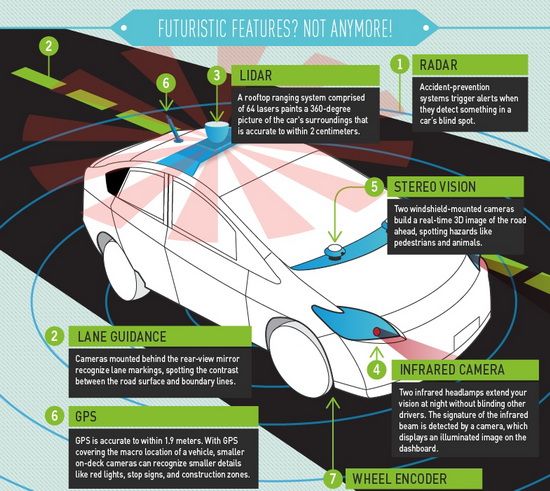With its public testing this summer of its in-house designed driverless car system, Google has brought the next level of automotive technology directly to our computer screens while automotive manufacturers are investing billions of dollars in the idea of empty cars cruising the streets.
While we may be a way off from busy roads without drivers, there can be no denying that autonomous vehicles are coming sooner than most consumers ever expected and understanding the technologies behind them is the first step towards adoption. Whether you plan to send your car out to pick up dinner without you as soon as possible or you want to know what types of cars to avoid with caution while driving given their lack of a human driver, here are four infographics and videos to better understand driverless cars:
1. Infographic: Driverless Car Technologies
 |
| Original Source: DanielRosen |
Imagining a future where distracted driving and accidental deaths are a thing of the past is one thing; developing technologies to make it happen is another altogether. Those technologies are outlined beautifully in this infographic, with accompanying diagrams and explanations making the job of learning a simple one for any viewer.
The second half of the infographic highlights exactly why driverless cars are so important to humanity at large, showcasing the 450,000 injuries and $230 billion per year in losses generated each year in the United States due to distracted driving. With their promise to eliminate the need to drive when one doesn't have the time for it, driverless cars could potentially end distracted driving altogether.
2. Video: Blind Man Tests Google's Driverless Car
The best way to understand the technology behind driverless cars is to see it in action and Google recently released a video that showcases the car they've been working on. The action follows a legally blind man who quickly jumps behind the wheel, stopping by a laundromat and passing through a fast food drive-thru window before returning home, all without touching the wheel or needing to watch the road.Given that the concept still feels very futuristic and remote to many people, this video serves as the ultimate tool in simply reminding us that, not only is it possible, it's here now.
3. Shocking Effects of the Google Driverless Car

Did you know that driverless vehicles created by Google have driven more than 1,000 hours on the open road with no human intervention and more than 140,000 hours with minimal human intervention? Given just how close this technology is to our driveways, this infographic takes a look at some of the real world effects that are likely to be seen as driverless vehicles become mainstream. Out-of-work taxi drivers, lost revenue for governments, the elimination of parking fees, increased free time - the list goes on.
The most important statistics offered here revolve around safety, showing once again just how effective driverless cars could be in reducing human injury and damages due to car accidents caused by driver distraction.
4. Video: Sebastian Thrun, Google Driverless Car Developer at TED Talks
Google's Sebastian Thrun, one of the lead developers in the team that helped to build Google's driverless car prototypes and an award-winning computer scientist and educator, paid a visit to TED Talks to give a quick lecture on autonomous vehicles in general and Google's efforts in that field in particular.Included in the video is footage of Google's vehicles cruising through urban streets, taking turns and making stops without the need for human intervention, an amazing testament to just how close driverless cars are to appearing in the consumer marketplace.
Annie is blogging for cheapcarinsurance.net, the free auto insurance resource.
No comments:
Post a Comment